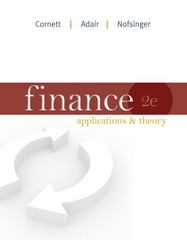






Capital Budgeting Assignment FNCE 301 Fall 2020 Toefield Inc. has developed a powerful efficient snow remover that is significantly less polluting than existing snow removers currently on the market. The company spent $2,000,000 developing this product and the marketing department spent another $300,000 to assess the market demand. It would cost $20 million at Year 0 to buy the equipment necessary to manufacture the efficient snow blower. The project would require net working capital at the beginning of each year equal to 20% of sales (NOWCO = 20%(Sales1), NOWC1 = 20%(Sales2), etc.). The efficient snow blowers would sell for $3,000 per unit, and Toefield believes that variable costs would amount to $790 per unit. The company expects that the sales price and variable costs would increase at the inflation rate of 2% after year 1. The company's non-variable costs would be $800,000 in Year 1 and are expected to increase with inflation. The efficient snow blower project would have a life of 4 years. If the project is undertaken, it must be continued for the entire 4 years. Also, the project's returns are expected to be highly correlated with returns on the firm's other assets. The firm believes it could sell 3,500 units per year. The equipment would be depreciated using a CCA rate of 30%. The estimated market value of the equipment at the end of the project's 4-year life is its undepreciated capital cost (i.e. book value) at the end of year 4. Toefield has other assets in this asset class. Toefield Inc.'s federal-plus- provincial tax rate is 30%. Its cost of capital is 9% for average risk projects. Low-risk projects are evaluated with a WACC of 6%, and high-risk projects at 12%. Assume that the half-year rule applies to the CCA. a. Develop a spreadsheet model and use it to find the project's NPV, IRR, and payback. Part 1. Input Data (in thousands of dollars except for unit amount) Part 1. Input Data (in thousands of dollars except for unit amount) Equipment cost Net Operating WC/sales Yearly sales in units) Sales price per unit Variable cost per unit Non-variable costs Tax rate WACC Inflation CCA rate Part 2. CCA Schedule year 1 year 2 year 3 year 4 Beg. UCC CCA End UCC Part 3. Projected Net Cash Flows (Time line of annual cash flows) Years 0 1 2 3 4 Investment Outlays at Time Zero: Equipment ears Investment Outlays at Time Zero: Equipment Operating Cash Flows over the Project's Life: Units sold Sales price Variable costs Sales revenue Variable costs Non-variable operating costs Depreciation (equipment) Oper. income before taxes (EBIT) Taxes on operating income Net Operating Profit After Taxes (NOPAT) Add back depreciation Operating cash flow Working Capital: Required level of net operating working capital Required investment in NOWC Terminal Year Cash Flows: Net salvage value Terminal Year Cash Flows: Net salvage value Net Cash Flow (Time line of cash flows) Part 4. Key Output: Appraisal of the Proposed Project Net Present Value (at 9%) IRR MIRR Payback (See calculation below) - Data for Payback Years Net cash flow Cumulative CF Part of year required for payback: 0 0 0 0 0 0.00 0.00 0.00 0.00 b. Now conduct a sensitivity analysis to determine the sensitivity of NPV to changes in the sales price, variable costs per unit, and number of units sold. Set these variables' values at 10% and 25% above and below their base case values. Include a graph in your analysis. Evaluating Risk: Sensitivity Analysis I. Sensitivity of NPV to Changes in Inputs. Here we use an Excel "Data Table" to find NPV for different unit sales, variable costs, WACC, and sales prices, holding other thing constant. WACC NPV NPV 0 SO % Deviation from Base Case -25% -10% 0% 10% 25% 1st YEAR UNIT SALES Units Sold SO 2,625 SO 3,150 SO 3,500 SO 3,850 SO 4,375 SO % Deviation from Base Case -25% -10% 0% 10% 25% SO WACC 6.75% 8.10% 9.00% 9.90% 11.25% SO SO SO % Deviation from Base Case -25% -10% 0% 10% 25% 0.59 VARIABLE COSTS Variable NPV Costs SO SO 0.71 SO $0.79 SO 0.87 SO 0.99 SO % Deviation from Base Case -25% -10% 0% 10% 25% SALES PRICE Sales Price 2.25 2.70 $3.00 3.30 3.75 NPV SO SO SO SO SO SO % Deviation NON-VARIABLE COSTS from Fixed NPV Base Case Costs SO -25% 600 SO -10% 720 SO Solution + Note about data tables. The data in the column input should NOT be input using a cell reference to the column input cell. For example the base case number of units sold in cell B100 should be the number 1000; you should NOT have the formula |=D29 in that cell. This is because you'll use D29 as the column input cell in the wrong values for the data table! Sensitivity Analysis Sales price VC NPV Units $11,000 $9,000 $7,000 $5,000 $3,000 $1,000 -$1,000 -$3,000 -$5,000 -$7,000 -20% Non-var. cost WACC -10% 0% 10% 20% Deviation from NPV at Different Deviations from Base Variable Non-variable Sales Price Sales Price 2 3 4. 5 5 7 3 Deviation from Base Case -25% -10% 0% 10% 25% $0 $0 $0 $0 $0 NPV at Different Deviations from Base Variable Non-variable Cost Units Sold Cost $0 $0 $0 $0 $0 $0 $0 $0 $0 $0 $0 $0 $0 $0 $0 WACC $0 $0 $0 $0 $0 0 $ 1 Range 2 3 4. 5 c. Would you recommend that the project be accepted? Explain. 3 7 3













